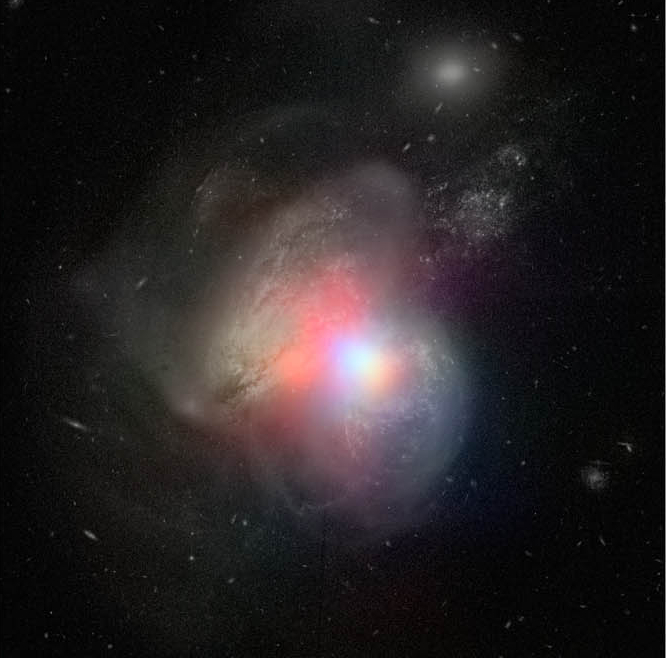
 Credit: NASA/JPL-Caltech/GSFC
Credit: NASA/JPL-Caltech/GSFC
Pinpointing a Monster
For galaxies, the Universe can be a crowded place. As they fly through space, they can collide with other galaxies, and these collisions can trigger all sorts of interesting behavior - star formation, supernovae, and outbursts from central supermassive black holes. A good example is the galaxy pair known as Arp 299, shown above, a merger of two individual galaxies known as IC 694 and NGC 3690. Light from this merger is dominated by infrared radiation produced by dust heated by bursts of star formation. In 2002, observations with the BeppoSAX X-ray observatory showed the first unambiguous evidence of X-ray emission from a feeding, heavily obscured supermassive black hole in the system. BeppoSAX was not able to determine where in the merger the black hole was located - in IC 694, NGC 3690, in both, or somewhere in between. Follow up observations with the Chandra X-ray Observatory and XMM-Newton failed to locate the monster. But the issue was finally put to rest by the NuSTAR hard X-ray observatory. NuSTAR is able to pinpoint very high-energy X-ray emission from black holes and other astrophysical objects. The high-energy X-rays which NuSTAR sees can penetrate enormous amounts of gas and dust. The NuSTAR image of Arp 299 is shown in the colored regions above: X-rays with energies of 4 to 6 kiloelectron volts are red, energies of 6 to 12 kiloelectron volts are green, and 12 to 25 kiloelectron volts are blue. The NuSTAR observations show that the supermassive black hole in NGC 3690, the galaxy on the right, is actively generating X-rays produced by the accretion of gas force-fed it by the merger of the two galaxies. On the other hand, NuSTAR shows that the supermassive black hole in IC 694, the galaxy on the left, is either dormant or so heavily obscured that even high energy X-rays can't escape.
Published: January 12, 2015
<
HEA Dictionary ● Archive
● Search HEAPOW
● Other Languages
● HEAPOW on Facebook
● Download all Images
● Education ● HEAD
>

Each week the HEASARC
brings you new, exciting and beautiful images from X-ray and Gamma ray
astronomy. Check back each week and be sure to check out the HEAPOW archive!
Page Author: Dr. Michael F. Corcoran
Last modified Monday, 26-Feb-2024 17:20:16 EST


